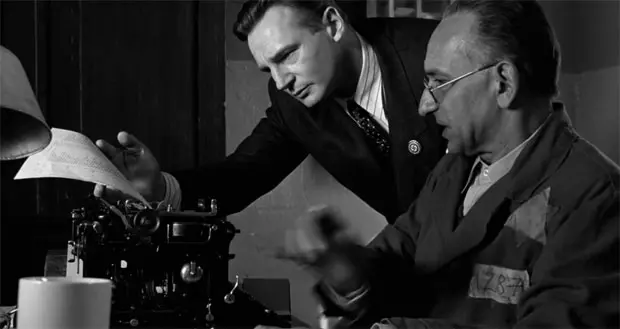 Between the mid-1980s and early 1990s, Steven Spielberg’s career seemed to be in a bit of a holding pattern (and that is putting it mildly). In the seven and a half years that followed his 1985 hit The Color Purple, the legendary director only had one outright commercial success: 1989’s Indiana Jones and the Last Crusade. 1987’s erratic Empire of the Sun was met with lukewarm critical praise but was an outright box office bomb. 1989’s fantasy drama Always didn’t fare much better, while the abysmal Hook made some money but is widely and rightfully regarded as the nadir in Spielberg’s career. At this point, there really was nowhere to go but up.
Between the mid-1980s and early 1990s, Steven Spielberg’s career seemed to be in a bit of a holding pattern (and that is putting it mildly). In the seven and a half years that followed his 1985 hit The Color Purple, the legendary director only had one outright commercial success: 1989’s Indiana Jones and the Last Crusade. 1987’s erratic Empire of the Sun was met with lukewarm critical praise but was an outright box office bomb. 1989’s fantasy drama Always didn’t fare much better, while the abysmal Hook made some money but is widely and rightfully regarded as the nadir in Spielberg’s career. At this point, there really was nowhere to go but up.
But which path would the filmmaker take? Would he go back to the popcorn escapism that made him a household name in the 70s and early 80s or would he continue to delve into the world of more serious-minded films for adults? If you are Spielberg, apparently you can do both. While Jurassic Park helped reaffirm his standing as the king of popcorn cinema, it was his other film from 1993 that really steered the latter part of his illustrious career: the Holocaust drama Schindler’s List.
Based on the Thomas Keneally novel Schindler’s Ark, List is the true story of Oskar Schindler (Liam Neeson), a German businessman who came to Poland in 1939 after the Nazis invaded the country to become a war profiteer. After winning over the Wehrmacht and SS officials that occupy Krakow, Schindler begins his army mess kit production by using Jewish workers, individuals who have been moved from their homes into the ghettos of Krakow and whose labor comes at a low cost.
Thanks to an official of the Jewish Council named Itzhak Stern (Ben Kingsley), Schindler’s business is a success and the Jews that work in his enamel factory find a bit of safe haven in being “essential workers.” But even that fragile safe haven cannot protect the workers from the increasing threats of being sent to concentration camps such as Auschwitz and exterminated. As the war progresses and the situation grows worse, Oskar finds himself wheeling and dealing with the Nazi commandants, in particular a barbaric animal known as Amon Goeth (Ralph Fiennes). He does so not to keep the money rolling in, but to save the people who made Schindler his fortune in the first place.
In the years that have followed Schindler’s List, Spielberg has made some fine adult dramas, among them Saving Private Ryan, the underrated Munich and last year’s Lincoln. Subject matters aside, none of these fine motion pictures have come close to the level of craftsmanship that is on display here. If he was to tell the story of Oskar Schindler properly while also taking up the task of honoring the six million murdered Jews without resorting to cheap sentiment or melodrama, Spielberg would have to put aside the Disney-esque directing technique that made him a household name and do some serious artistic growing up.

He certainly did that, but also did so much more. Despite having a breathless pace that rivaled his best commercial work, this was a Steven Spielberg we had never seen before. His documentary-style approach to the storytelling also displayed remarkable restraint, with the latter allowing the power of Steve Zaillian’s brilliant screenplay and the film’s incredible acting ensemble (the three male leads were criminally ignored at the Oscars that year) to shine through. By deliberately pacing the transformation of Schindler from war profiteer to savior, Spielberg and company gave the movie’s small, quiet sequences of compassion and humanity as much emotional heft and lasting viewer impact as the random and often sudden outbursts of graphic violence did.
It takes a special kind of filmmaker to make a movie about the darkest chapter in modern history and have one come away hopeful for humanity, but that is exactly what Steven Spielberg did with Schindler’s List. Very few films from the past half century have a chance of standing the test of time. This is not one of them. Spielberg’s rebirth as a filmmaker, and the finest hour of his remarkable career, not only will be remembered fondly in the years and decades to come, it will do the near impossible: it will get better with age, like a fine wine. I think Oskar Schindler would approve.
High-Def Presentation
For once, Universal’s boast of ‘Perfect Hi-Def Picture, Perfect Hi-Def Sound’ is actually true. For its twentieth anniversary, Schindler’s List was given a restoration that was overseen by Steven Spielberg. After seeing the results on this 1080p/AVC-encoded transfer, I really wish he would supervise every catalog transfer Universal Home Video does. The Blu-ray transfer of Schindler’s List is right up there with those of Jaws and E.T. It is absolutely breathtaking. Janusz Kasminski’s Oscar-winning black-and-white cinematography for Schindler has always been a sight to behold, but here it seems to take on another dimension.
Black levels are remarkably deep, the picture detail is spot on and there is fine layer of grain throughout. Even the most troublesome aspect of the theatrical prints, the sequences with that featured The Girl in the Red Coat, have been handled with the utmost professionalism.
The DTS HD-MA Audio is as clear as a bell. Given the documentary-style approach to the movie, the film is largely a front speaker affair and his handled with the utmost of care. Rear-channel surrounds and LFE channels are used quite sparingly, but that is certainly not a knock against the transfer. The movie has been given the utmost respect by Universal Home Video and it shows in every frame.

Beyond the Feature
Spielberg has gone on record in saying that he has always wanted Schindler’s List to speak for itself. That means no audio commentary, no retrospective documentary on the making of the movie or its legacy. While this is extremely disappointing for fans of the film such as me, it is a decision that one can in the end respect.
Does this mean that the new Blu-ray is completely lacking in the supplemental department? No. The bonus materials that accompanied the 2004 DVD release have been ported over to this edition. Actually, the DVD edition has been included in the set with the extras housed on disc two. Normally, that would be an issue. But if it means that keeping the extras off of the Blu-ray gives the movie more breathing room, then so be it.
- Voices From the List: Running close to eighty minutes, this powerful documentary is a collection of interviews from real-life Holocaust survivors who knew Schindler. If you are up for it after watching the movie, this makes for a compelling coda to your evening’s viewing.
- USC Shoah Foundation Story With Steven Spielberg (5 minutes): A brief look at the Institute for Visual History and Education that Spielberg established at USC after filming Schindler’s List.
- About IWitness (4 minutes): A look at the highly-regarded education website IWitness, which was developed by the USC Shoah Foundation. The website helps bring the recorded testimonies from the Visual History Archive to secondary school teachers and their students via multimedia.
Schindler’s List was one of the final big catalog holdouts to make it to the Blu-ray format, and the Universal Home video presentation does not disappoint when it comes to the film’s video and audio transfers. They are remarkable. One could complain about the lack of retrospective supplements, but when a movie speaks for itself this powerfully it is hard to bemoan the lack of bonus material. Schindler’s List may very well be the most important film to come out of Hollywood in the last century. To this reviewer, it was certainly the best.
– Shawn Fitzgerald
Shop for Schindler’s List on Blu-ray for a discounted price at Amazon.com (March 5, 2013 release date).



